(24) ARACHNIDA - ORDER VII: ARANEIDEA - EXTERNAL STRUCTURE
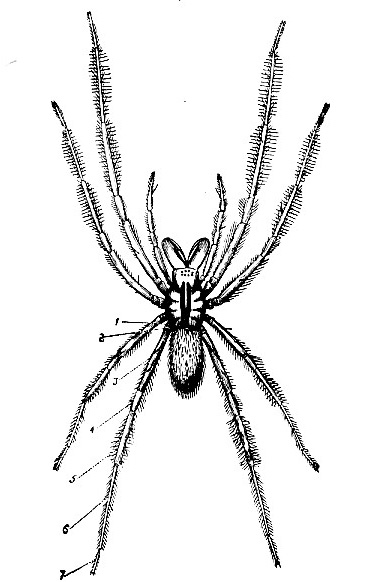
Fig. 26. Spider (Cambridgea fasciata, Koch.). Adult male.
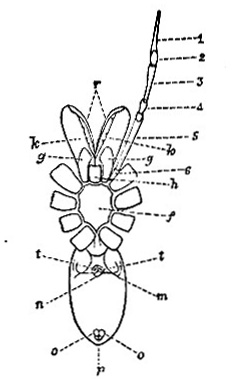
Fig. 27 -- Cambridgea fasciata: adult male, under side, with legs and one palpus truncated. f, sternum; g, g, maxillae; h, labium; k, k, falces with r fangs of ditto; m, one of the ordinary spiracular orifices (the corresponding one on opposite side not lettered); n, genital aperture, leading, in the male, only to spermatic vessels; o,o, spinners; p, anal orifice; t, t, extra pair of spiracular openings; 1, digital joint of palpus; 2, palpal organs; 3, radial joint; 4, cubital; 5, humeral; 6, axillary.
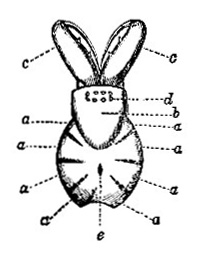
Fig. 28 -- The same, upper side of cephalo-thorax. a...a, coalesced thoracic segments; b, caput; c, c, falcus; d, eyes; e, central indentation.
We have come now, by an easy transition from the Phrynides, to the last order of Arachnids- Araneidea or True Spiders (figs. 26, 27, 28). And first, with regard to their EXTERNAL STRUCTURE, they consist, like others of the sub-class Arachinda, of a body divided into two parts -cephalo-thorax and abdomen; but these are united only by a slender pedicle, and neither is segmented, ringed or articulated, nor (in respect to the abdomen) covered with horny plates, except in two instances - Liphistius desultor (Schiodte) and (but partially only) Tetrablemma medioculatum (Cambridge), both exceedingly rare and remarkable species. The cephalo-thorax, though undivided, yet shows by its various, and more or less strongly marked, converging grooves and indentations, that it is composed of the ordinary cephalic and thoracic segments soldered together; and although these segments form but one undivided portion of structure, it is necessary to speak of it frequently by the names of its two portions - caput and thorax. The caput is almost always easily traced, forming a kind of wedge-shaped portion, jammed (as it were) into the first of the thoracic segments, and giving one the idea, in most cases, of its fore part having been to a greater or less extent truncated or lopped off (fig. 28, b). Similarly the last of the four thoracic segments has the appearance of having been driven in to meet the caput, all the segments thus converging, on the upper side, towards a common fovea, or more or less deep central indentation (fig. 28, e), and on the under side forming a sternum (or sternal plate), in which however, no appearance of segmentation is generally visible beyond small eminences opposite to the articulation of the legs, with which the number of the thoracic segments, as seen above, agrees. The integument of the cephalo-thorax is either hard, horny, or coriaceous, generally more or less clothed with hairs and bristles, and sometimes, though more rarely, with tubercles and spines; occasionally it is perfectly smooth and glabrous. The eyes, when present, are two, four, six, or eight, and are very variously, but always symmetrically, disposed on the fore part of the caput (figs. 28, 29, 30). The number and general position of the eyes form valuable characters for the formation of genera; while their relative size is strongly characteristic of species. The eyes of spiders, like those of other Arachnids, are always simple.
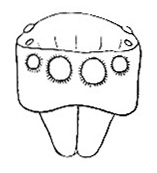
Fig. 29 -- Caput of Attus ___ ? showing position of eyes.
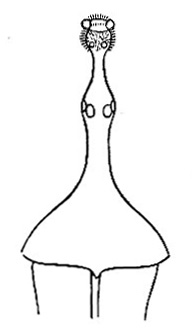
Fig. 30 -- Caput of Walckenaëra acuminata, Blackw., showing position of eyes.
The legs, eight in number, are articulated to the sternal plate (mentioned above) which forms the under side of the cephalo-thorax; in one genus, however (Maigrammopes, Cambr.), found in Ceylon and Australia, no sternum properly so called exists, the legs being articulated to the continuous under side of the cephalo-thorax. Except in one or two species the legs are seven-jointed, and variously furnished with hairs, bristles, and spines. Many spiders have a kind of pad of closely set papillae-form hairs beneath the extremity of the tarsi of some or all the legs, and often extending along the whole of the under side of the joint. This pad enables the spider to run over smooth vertical surfaces, acting as a kind of sucker, partly by atmospheric pressure, and partly (Mr Blackwall thinks wholly) by means of a viscid secretion from the papillae-form hairs. Each tarsus ends with either two or three more or less curved or bent claws, commonly (nut not always) pectinate or finely denticulated; these (with other opposed serrated claws, in some groups) are used in traversing their webs, and as hooks to give a tension to the line of their snares by alternately pressing and staining upon them; the spines and bristles are used also in many cases in the actual construction of the silken snares in which spiders entrap their prey. The spines on the legs of some spiders which excavate cylindrical holes in the earth (lined with silk and closed with a hinged lid) are very strong, and well suited for digging out the soil. The males of some species again, have a curious row of short, closely set, curved, spiny bristles along a portion of the upper side of the metatarsi of the fourth pair of legs; the use of this row of bristles (called the calamistrum) is alluded to further on. The length of the legs in spiders(both actual and relative) is very various; and the differences between them as well as their armature and terminal claws, furnish valuable characters, often generic, and always important in the determination of species.
The falces, two in number, are articulated immediately below the fore margin of the caput; their direction is various, ranging from a line parallel to the plane of the cephalo-thorax to one perpendicular to it; they are in general opposed to each other, and in most cases are armed with teeth on their inner surface, especially towards the extremities; each also terminates with a movable curved fang, which, when not in use, is (according to its mode of articulation) folded down either across the inner side of the extremity of the falx, or (as in one extensive family, Theraphosides) backwards along its length; by means of these fangs, which are internally channeled and perforated at their extremities, a poison secreted within the caput is instilled into the wound made by them, proving, no doubt, fatal to the spider's prey, and often nearly so to human beings. Not to dwell upon the, probably exaggerated, accounts. Not to dwell upon the, probably exaggerated accounts of the Tarantula, there are well authenticated instances of recent date in regard to the very deadly nature of the poison of quite a small spider, Lantrodectus Katipo (Ll. Powell), found in New Zealand (Trans. N.Z. Instit. Iii. p. 56; also ld. Ii. p. 81, and iii. p. 29). A larger European species of the same genus, L. oculatus (Walck.), also bears the reputation of being venomous.
The maxillae are a conspicuous, as well as an important, portion of structure in the Araneidae, they are two strong pieces situated immediately behind the falces, exceedingly varied in form and strength, and articulated to the fore side of the sternum between the basal joints of the first pair of legs. Their real direction is always divergent, i.e. outwards from each other, but as in most cases the inner extremity is produced into an apophysis of greater or less size (sometimes following the direction of the maxilla, sometimes curved so that its extremity almost touches that of the opposite maxilla), the maxilla itself often seems lost in the part which projects from it. Owing to this, the palpus which springs from each maxilla, although really always springing from its extremity, appears more frequently to issue from its outer side; and, in fact, it can hardly in those cases be described (without leading to some confusion) as issuing in any other way. The form of the maxillae, together with the apparent point of palpal issue, constitutes one of the most valuable characters for the establishment of genera.
The palpi, issuing from the maxillae as just described, are two (in both sexes of many, and in the female sex of most species, leg-like) limbs, of five or (counting the basal joint-maxilla-to which each is articulated) six joints; in the female spider the palpi generally end with a single, and sometimes denticulate, curved claw, in some instance, however, there is no terminal palpal claw; but in the male, the third (cubital) and fourth (radial) joints of the palpi are (the former often, the latter always) characterized by prominences, spiny apophyses, or protuberances, which furnish some of the strongest, as well as most tangible, specific characters of that sex; the last (or digital) joint of each palpus (in the male spider) is generally more or less concave, and always includes, either within its concavity or articulated to its under side, a ( frequently complex congeries of corneous lobes, spines, and spiny processed, in some instances articulated to each other so as to be capable of being opened out as by hinges. These are not developed until the spider arrives at maturity. Up to that period the digital joint has a tumid and somewhat semi-diaphanous appearance, and, although commonly smaller, bears the same general form that it has after maturity. These processes, or, as they are called, palpal organs, are connected with the process of reproduction-the fecundation of the female. This subject however, we shall have occasion to refer to again. The palpi are generally furnished more or less with hairs, bristles, and spines, like the legs; and like them, also, are reproduced after accidental loss.
The labium is also another important portion of structure; it is situated at the fore extremity of the sternum, between and in front of (or rather beneath) the maxillae; it is of varied form and size, and stopping the gap between the maxillae, it completes with them the inferior and lateral boundaries of the mouth, the falces forming its upper limits. The labium is always present, except in a new and very remarkable Brazilian spider, Aphantochilus Rogersii (Cambr.), in which the labium is wanting, and yet not wanted, because the maxillae, in this instance, close up to each other, leaving no gap between them.
Between the labium and falces is another portion of structure, the tongue; it is, no doubt, by the aid of this that the act of swallowing the juices of insects, when expressed by the falces and maxillae, is effected; that, in fact, the spider eats without being choked. No use hitherto has been made of the tongue in spiders for purposes of classification, but the form of the labium is very useful for the characterization of genera. These parts - falces, maxillae, labium, and tongue-thus complete the mouth parts of a spider.
The sternum has already been mentioned; its form varies from oval to heart-shaped, and sometimes somewhat pentagonal; its convexity also varies considerably; its use in classification is rather limited, but with its clothing of hairs, bristles, or pubescence, or its sometimes glabrous nature, it generally has some specific importance. In one known genus only, as mentioned above, is the sternum wanting.
The abdomen is exceedingly varied in form in different families; it is united to the cephalo-thorax by a short narrow pedicle, and generally terminates with organs for soinningl in one species, Liophistius desultory (?) (Schiodte), the spinners are placed near the anterior part of the under side of the abdomen; and in another, Mutusca mammosa (Cambr.), one pair only are so placed, the rest occupying the ordinary position. The number of spinners varies - two, four, six or eight; they are placed in pairs, and when a fourth pair is present it is, usually as a single one, united throughout its length (but with often a line of division visible), and occupying a transverse position in front of the rest. it is but very lately that spiders have been observed with two spinners only; see "Spiders of Palestine and Syria," O.P. Cambridge, Proc. Zool. Soc. 1872, p. 260; Ann. and Mag. N.H. 1870, pp. 414-417, Ibid.
The spinners consist of from one of three joints, and vary greatly in size and structure, as well as in number, but their use in classification has not hitherto been as great as might have been expected; generally they are separate, but in Tetrablemma (Cambr.) they are enclosed in a kind of corneous sheath. Those of the fourth pair when present (which they are in both sexes) are correlated, but in general only in the female sex, with the calamistrum, or double series of curved bristles before mentioned, on the metatarsi of the fourth pair of legs. The function of the calamistrum has been proved by Mr Blackwall to be the carding, or teasing and curling, of a peculiar kind of silk, secreted and emitted from the fourth pair of spinners when thus prepared this silk becomes adhesive, from its minutely divided and elastic fibres; and, disposed about the lines of the spider's snares, it renders more easy the entanglement and capture of their prey. Immediately above the spinners is a small nipple0like prominence which indicates the anal orifice.
The abdomen is covered with a continuous integument neither annulate nor segmentate; in one species, however (before mentioned), Liphistius desultory (Schiodete), the upper side has a longitudinal series of transverse corneous plates, like those of the Phrynides; and something of a similar kind, but less marked, is observable in Tetrablemma medioculatum (Cambr.), a very rare and remarkable little spider found in Ceylon. The epidermis of the abdomen is of various kinds and consistency in different groups, sometimes excessively thin and tender, at other times tough and coriaceous, and sometimes hard and horny, with a varied armature and clothing of hairs, bristles, puberscence, tubercles, and spines, sometimes being, however, perfectly bare and glabrous; its colours, also, and the patterns produced by their distribution, vary exceedingly. Under neath the fore extremity of the abdomen are placed t he external openings to the respiratory organs; these apertures consist of a narrow slit or orifice under the force edge of round or oval scale-like plates, placed on each side of the median line; such plates are in some spiders four in number, but for the most part only two. Other spiracular openings also exist in many spiders, both at the anterior part of the under side (figs. 288, t,t) and near the spinners (Siebold), but these are usually far less perceptible than the others before mentioned, and often discoverable with great difficulty. The ordinary pair of spiracular plates are in general very conspicuous, commonly differing in colour from the surrounding surface, and sometimes slightly pubescent. They occupy each side of the median line at the extreme fore part of the under side of the abdomen; and between them is, in the male spider, a very minute orifice which leads to the seminal organs; while in the same situation in the female is an aperture usually rather conspicuous always of characteristic form, and often furnished with a corneous process of greater or less development. This aperture is the vulva, and the process (when present) probably has the function of an ovipositor. The form and structure of this aperture is of great use in the determination of species, but until the female spider attains maturity no aperture at all is visible. The orifices to the breathing organs are fringed with hairs or lashes, and open and close by an internal muscular arrangement. The other pair of spiracular plates, when present, are in some case close behind those just above mentioned, but more commonly at some distance further towards the hinder extremity of the abdomen.
On the upper side of the abdomen may be seen in many spiders several impressed spots or dots, differing in number and position in different genera and species, but always placed symmetrically. These, considered by Treviranus as stigmatic openings, are probably indicated points of fixture for muscles beneath the integument, being apparently imperforate. Smaller puncture-like marks are also often visible on the under side, and are perhaps similarly caused. The hairy clothing of the abdomen (as well as of the cephalo-thorax and other parts), variously tinted and coloured, gives the specific pattern to the spider from its diversified distribution; and when such clothing is absent, the pattern is often equally distinct and varied, arising in such cases form a pigment in the coats of the integument itself.
Read the rest of this article:
Arachnida - Table of Contents
|




